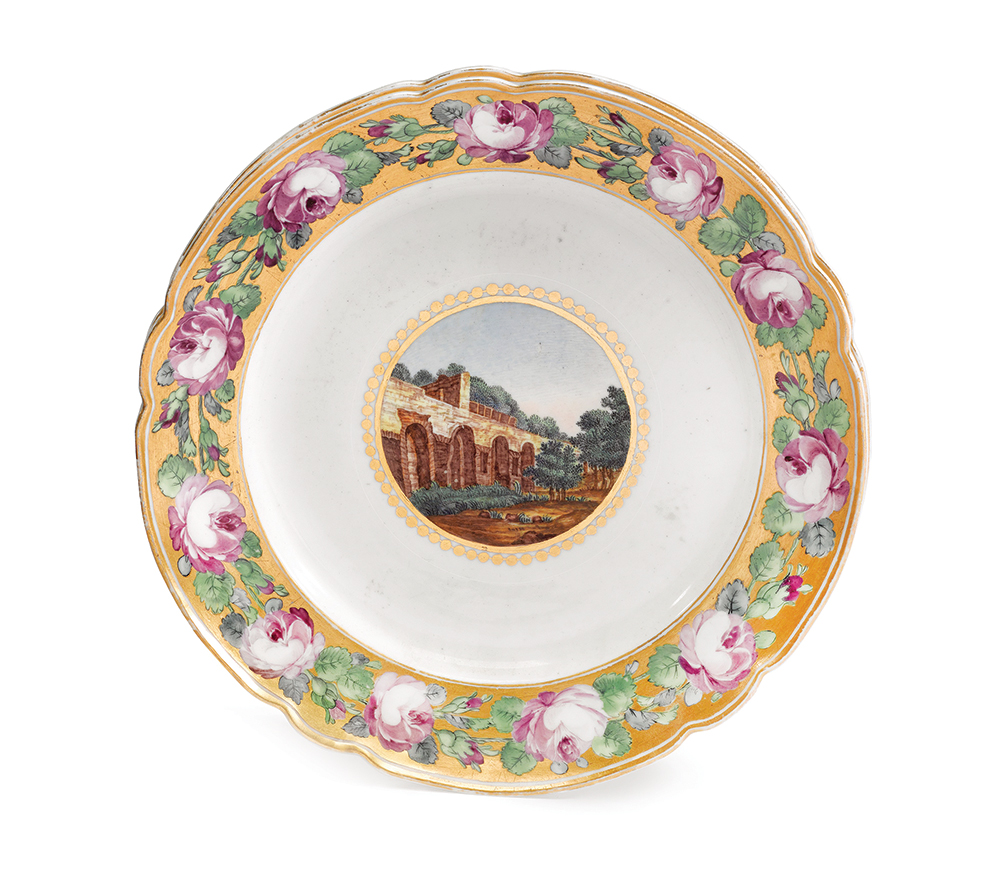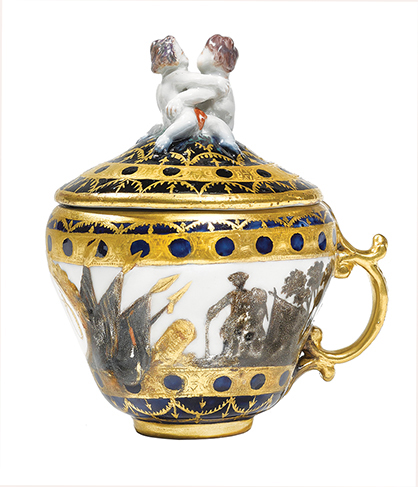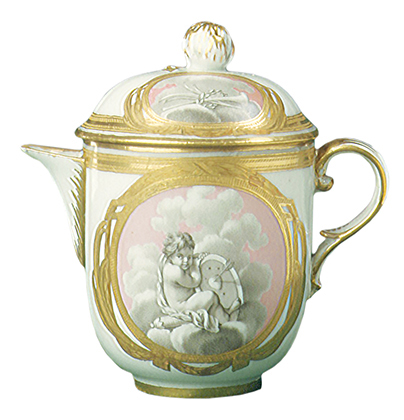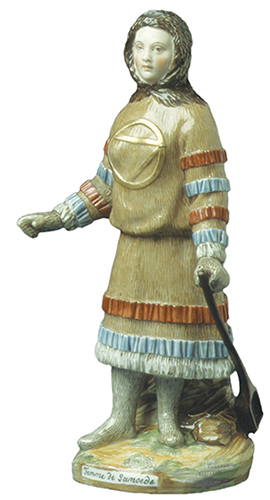A Place at the Imperial Table
Writer Leslie Gilbert ElmanCatherine the Great was passionate about porcelain

The central motifs on the Cabinet (or Kabinetsky) Service depict ancient sites that fashionable 18th-century ladies and gentlemen would have visited on a Grand Tour of Europe. The pink peony border reflects Catherine the Great’s romantic nature. Courtesy of Sotheby’s.
No one set a table like Catherine the Great. When you’re the Empress of All the Russias, you can afford to be extravagant, and porcelain was one of Catherine’s passions. Conveniently, she had her own porcelain company to produce whatever she desired.
The Neva Porcelain Manufactory was established in 1744 by Empress Elizabeth, whose life was every bit as colorful and chaotic as Catherine’s. Like her father, Peter the Great, Elizabeth loved and admired beautiful things. She threw legendary parties that cost ridiculous amounts of money and when she died in 1762, she left a huge amount of debt and an unfinished Winter Palace in St. Petersburg.
Tsar Peter III, who was Elizabeth’s nephew and Catherine’s husband, succeeded Elizabeth. He didn’t last long. By the end of 1762, Catherine was ruling Russia.
Sharing Elizabeth’s aesthetic sense, but with a keener mind for management and finance, Catherine oversaw completion of the Winter Palace. She also reorganized and rebranded the Neva Porcelain Manufactory as the Imperial Porcelain Manufactory, purveyors to the Russian court.

Catherine the Great ordered the Orlov Service as a gift for her lover, Count Grigory Orlov. The sides of this covered chocolate cup have military-themed decoration. Its top is adorned with embracing cherubs. Rare and precious, this single piece reached a five-figure price at a 2018 Sotheby’s London sale. Courtesy of Sotheby’s.
The factory’s first significant imperial commission was a gift from Catherine to Count Grigory Orlov, the military officer who organized the coup that put her on the throne. The 300-piece breakfast and toilette set with cobalt and gold military-themed decoration was a lavish gift, even considering that Orlov was more than a political ally, he was also the father of Catherine’s illegitimate son.
The first porcelain service Catherine commissioned for her own use was the Arabesque (Arabeskovy) Service, completed in 1784 and numbering more than 900 pieces. Bordered in pink and gold, it features motifs taken from antiquities unearthed at the 18th-century excavations of Pompeii and Herculaneum.
A year later came the Yacht (Yakhtinsky) Service, trimmed in pink with an insignia depicting a double-headed black eagle and crossed anchors.
The Cabinet (Kabinetsky) Service, made in the 1790s, was more elaborate still, featuring detailed depictions of classical Italian architectural sites based on engravings made by Jean Houël for his 1782 book Voyage Pittoresque des Isles de Sicile, de Lipari et de Malte. And for regular use, there was the Everyday Service, decorated with charming sprays of flowers.

Catherine was known to give “tête-à-tête” tea sets for two as wedding gifts to her ladies in waiting. Now in the collection of the Metropolitan Museum of Art, this covered milk jug with its romantic cherub decoration might have been part of one such set. Courtesy of the Metropolitan Museum of Art.
One of the firm’s more interesting imperial commissions was “The Peoples of Russia,” based on engravings from Johan Gottlieb Georgi’s book A Description of all the Peoples of the Russian Empire. Jean-Dominic Rachette, the factory’s chief model maker, crafted more than a hundred figures representing the Russian Empire’s many ethnic groups, documented for posterity in porcelain.
Catherine engaged other porcelain firms as well. The Gardner porcelain factory—a Russian manufactory founded by Englishman Francis Gardner—produced four services for use at ceremonial banquets honoring the knights of the Imperial Orders of St. Andrew First Called, St. George the Martyr, St. Alexander Nevsky and St. Vladimir.
From the English firm, Josiah Wedgwood and Sons, she commissioned a 944-piece service decorated with English landscapes and crowned with a frog coat of arms. Known as the Green Frog Service, it was used at her summer palace, Kekerekeksinsky, which was situated beside a frog marsh.
And for Prince Grigory Potemkin (who replaced Orlov in her affections), she had the French Sèvres porcelain manufactory produce the one-of-a-kind Cameo Service, decorated with classical Roman relief portraits, gilded trim and a “celestial” turquoise blue ground. Ordered in 1776, the service didn’t arrive in Russia until 1782—by which time Catherine’s love affair with Potemkin had run its course. It’s said that producing the set nearly bankrupted Sèvres. Catherine didn’t pay the final installment on her invoice until 1792.
Porcelain was an artistic and indulgent, yet arguably practical, gift for someone who did a lot of formal entertaining on a vast scale. It was also an ideal diplomatic gift from one monarch to another—especially if relations were rocky between them.

“Samoyed Woman” was modeled by Jean-Dominic Rachette based on drawings in John Gottleib Georgi’s 1770s survey of Russia’s ethnic populations. This piece is one of several Imperial Porcelain Manufactory “Peoples of Russia” figures in the collection of the Metropolitan Museum of Art in New York City. Courtesy of the Metropolitan Museum of Art.
Which brings us to the story of Flora Danica, the porcelain service Catherine the Great never owned.
In the Russo-Swedish War of 1788-1790, Denmark allied with Russia. But when Denmark was unable to fulfill its military obligation, the Danish king knew he needed to appease the empress with a grand gesture. So he commissioned a gift: a glorious, gold-trimmed porcelain service decorated with hand-painted botanical illustrations of the plants and flowers of Denmark—the “Flora Danica.”
Numbering more than 1,800 pieces, the service took 12 years to produce. By the time it was finished, Catherine the Great was long dead. So, being a monarch with a passion for porcelain himself, Danish King Christian VII kept it for his own royal table instead.
Leslie Gilbert Elman is the author of Weird But True: 200 Astounding, Outrageous and Totally Off the Wall Facts. She writes about antiques and other subjects for Design NJ.
